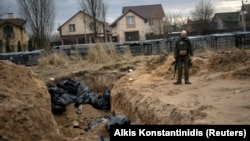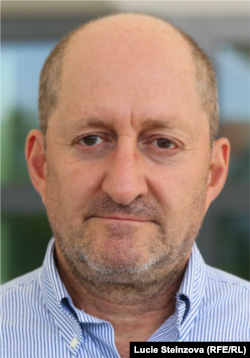With Russian forces seeking to cement their control and Kyiv fighting to take back its territory, the fate of a swath of southern Ukraine is uncertain. But one thing is clear: As in the north and east, accounts of torture, rape, and other atrocities are emerging as the war grinds on.
Here are some of the key developments in Russia over the past week and some of the takeaways going forward.
Mottos And Maps
On July 20, Russia’s foreign minister said that the “geography” of the Kremlin’s goals for the war in Ukraine has changed, naming two regions beyond the Donbas that he made clear Moscow wants to control in full and forever: Kherson and Zaporizhzhya.
Sergei Lavrov also said there were “a number of other territories" in Russia’s sights but declined to name them and added that Moscow could expand its objectives further if the West supplies Kyiv with longer-range weapons.
One of the aims of these remarks appeared to be to create a kind of slide rule, an adjusting scale that would allow the Kremlin to argue -- both to the West and to Russians -- that as it seized control of territory in a foreign country, whatever amount it ends up with is the right amount.
Another goal may have been simpler: to suggest that despite the spectacular failure of Russian forces to take Kyiv and remove President Volodymyr Zelenskiy’s government or force its surrender, Moscow may still have such goals in mind. This was reinforced by Lavrov's indication that the demilitarization and "de-Nazification" of Ukraine -- the latter linked to Russian President Vladimir Putin's false claim that the country is run by neo-Nazis -- remain among Moscow's war aims.
Others in Putin’s orbit have laid out highly ambitious objectives in more flamboyantly bellicose fashion.
In Chechnya, troops controlled by Kremlin-backed regional strongman Ramzan Kadyrov have been filmed wearing uniforms with the words "To Kyiv" in Russian on the back, though this seems far more likely to be a provocative piece of propaganda meant to frighten and impress than a statement of actual tactical intent. It’s also a reference to World War II wording about the Soviet Army’s advance on Berlin.
Former President Dmitry Medvedev -- the Putin “tandem” partner whose wildly pro-war, anti-West Instagram rants are widely seen as an at-once alarming and risible effort to stay relevant both in Russia’s war-crazy present and when the post-Putin era arrives -- posted a map showing a partitioned Ukraine, with large swaths belonging to Russia and other neighbors and a rump state controlling only a small area around Kyiv.
Mottos and maps notwithstanding, and despite the fact that Russian rockets struck areas near Kyiv for the first time in weeks on July 28, military analysts say the prospect of Moscow’s forces taking the capital is extremely unlikely given the challenges they are facing elsewhere, including in finding replacements for the roughly 75,000 soldiers U.S. authorities estimate have been killed or wounded since Putin launched the large-scale invasion of Ukraine on February 24.
Russian forces have been making slow progress in fierce fighting in the Donbas, compete control of which appears to be Putin’s minimum goal -- and perhaps the most modest territorial gain he could sell to Russians as a victory. While Russian forces now hold Luhansk Province in its entirety, about half of Donetsk Province remains under Ukrainian government control.
The South
In Kherson Province, where the regional seat remains the biggest city outside the Donbas that Russian forces hold, months after they seized it, the Ukrainian military has taken back some villages and there is talk that Kyiv could soon step up its counteroffensive. Ukrainian officials have said they plan to retake much of southern Ukraine within months.
Meanwhile, if the final geography of Russia’s ambitions in Ukraine remains uncertain, the geography of abuses by its forces and its representatives in the areas it controls -- or controlled briefly -- is growing increasingly clear.
In the north, weeks after pouring down toward Kyiv from Russia and Belarus, Russian forces retreated across the border, leaving evidence of summary executions, rape, and torture that are forming the foundation for war-crimes investigations even as the war continues.
In the east and the Donbas, people who have fled places like Mariupol, razed by Russian forces in a months-long siege, have delivered accounts of abuses and rights activists fear that much more will come to light later from areas where the fighting is heavy.
In southern Ukraine, evidence emerging from areas held by Russia paint a similarly grim picture, as Moscow seeks to solidify its control and quash Ukrainian resistance.
‘An Abyss Of Fear’
In a July 22 report citing dozens of people from the occupied parts of the Kherson and Zaporizhzhya regions -- Lavrov’s “changed geography” -- Human Rights Watch said Russian forces have turned the areas they control “into an abyss of fear and wild lawlessness.”
“Torture, inhumane treatment, as well as arbitrary detention and unlawful confinement of civilians, are among the apparent war crimes we have documented,” HRW said.
Its report documents harrowing accounts of torture and abuse. One woman from Kherson, Alyona Lapchuk, said she along with her husband, Vitaliy, and their son were taken to a police station with bags over their heads on March 27.
Lapchuk and her son “could hear them beating and interrogating her husband in the next room,” the report says. Russian soldiers then told her that her husband, a member of the Territorial Defense Forces, was a terrorist, and drove her and her son away and left them under a bridge.
Lapchuk searched for her husband for weeks. On June 10, she said, a prosecutor told her that a man catching crayfish found his body floating in a bay, his arms bound and a weight tied to his legs.
“All that time I had been praying that he was alive,” she said.
NOTE: The Week In Russia will next appear on August 12








